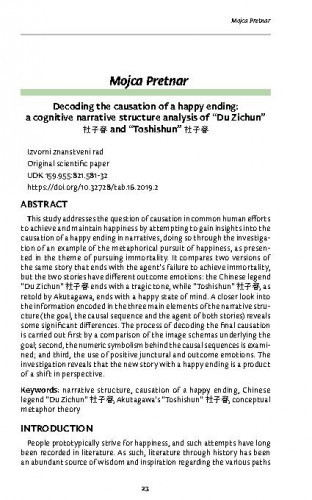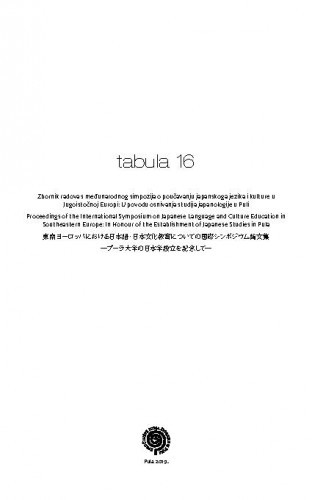This study addresses the question of causation in common human efforts to achieve and maintain happiness by attempting to gain insights into the causation of a happy ending in narratives, doing so through the investigation of an example of the metaphorical pursuit of happiness, as presented in the theme of pursuing immortality. It compares two versions of the same story that ends with the agent’s failure to achieve immortality, but the two stories have different outcome emotions: the Chinese legend “Du Zichun” ends with a tragic tone, while “Toshishun” as retold by Akutagawa, ends with a happy state of mind. A closer look into the information encoded in the three main elements of the narrative structure (the goal, the causal sequence and the agent of both stories) reveals some significant differences. The process of decoding the final causation is carried out first by a comparison of the image schemas underlying the goal; second, the numeric symbolism behind the causal sequences is examined; and third, the use of positive junctural and outcome emotions. The investigation reveals that the new story with a happy ending is a product of a shift in perspective.; Studija se bavi pitanjem uzročnosti u zajedničkim ljudskim nastojanjima da se postigne i održi sreća nastojeći steći neke uvide u uzročnost sretnoga završetka u narativima, radeći to kroz istraživanje primjera metaforičkoga traganja za srećom, kako je prikazano u temi traženja besmrtnosti. Studija razmatra moguće uzroke koji dovode do sretnoga završetka uspoređujući dvije verzije iste priče koja završava neuspjehom agenta da postigne besmrtnost, ali dvije priče imaju različite ishodišne emocije: kineska legenda dinastije Tang “Du Zichun” završava s tragičnom tonom, dok “Toshishun” koju je stvorio otac moderne japanske kratke priče Akutagawa, završava sretnim stanjem uma. Detaljniji uvid u informacije kodirane u trima glavnim elementima narativne strukture: cilj, uzročna sekvenca i agent u obje priče, otkriva neke značajne razlike između priča koje utječu na cijelu njihovu recepciju i ishod. Proces dekodiranja konačne uzročnosti provodi se kao prvo usporedbom dviju glavnih shema koje leže u osnovi cilja, a to su sheme PUT i CIKLUS zajedno s konceptualnim metaforama na kojima se temelje; potom se ispituje brojčana simbolika iza uzročnih sekvencija; i naposljetku, upotreba pozitivnih emocija radosti i ljubavi kao prosječnih i ishodišnih emocija – koji svi zajedno pokazuju vješti narativni pristup suvremenoga autora. Uza sve očite sličnosti između dvije verzije priče prikazane u ovome radu, istraživanje otkriva da je nova priča sa sretnim završetkom proizvod promjene perspektive.
Sažetak

 Tabula : časopis Filozofskog fakulteta, Sveučilište Jurja Dobrile u Puli : 16(2019) / glavni i odgovorni urednik Robert Blagoni.
Tabula : časopis Filozofskog fakulteta, Sveučilište Jurja Dobrile u Puli : 16(2019) / glavni i odgovorni urednik Robert Blagoni.